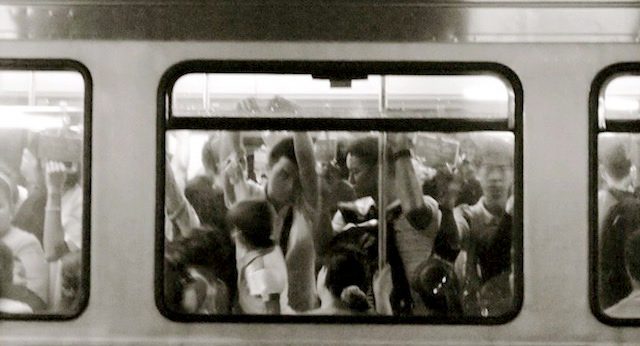SUMMARY
This is AI generated summarization, which may have errors. For context, always refer to the full article.

What do you do if the ticketing system of the train breaks down, and it takes two hours for the system to be restored? If, as a result, you were late for work and your late minutes were deducted from your paycheck? Or, if you’re a student, you missed an important test?
a. You take to social media to vent your rage.
b. You vow to wake up even earlier tomorrow morning to avoid being tardy.
c. You write a complaint letter to the head of the transit authority.
We, in Metro Manila, would easily choose options A or B. Here, no single group exists to speak for us, the people who take public transit. (There are two prototype groups – Commuters of the Philippines and MRT: Mga kuwento ng Realidad sa loob ng Tren – on Facebook.) So we just rant about how commuting is the worst part of our day and live with it.
New Yorkers, on the other hand, can do option C with a few clicks. All they need to do is go to the New York Public Interest Research Group’s Straphangers Campaign website. There they’ll find forms and tips for filing complaints that get results.
Powerful voices
Fed up with the dismal state of our buses and trains? Time to unite, fellow straphangers. We can channel our outrage and start a transit riders’ group. Then we can advocate for clean, safe, and reliable public transit in our cities.
“Organized riders” is one of the key elements of a successful transit campaign, writes Greg LeRoy in Organizing Transit Riders: A How-To Manual. “The people who depend upon transit have the most powerful and effective voices,” he says.
That means us, transit riders. Eight out of 10 people in Metro Manila take public transit. And that figure includes children, the elderly, and persons with disability. They suffer more as they squeeze into jam-packed trains and rickety buses and jeeps and endure long travel times.
Big wins
We have much to learn from the transit riders’ groups in other places. They have done some amazing things:
- In Los Angeles, the Bus Riders Union (BRU) sued the county’s metropolitan transportation authority (MTA) in 1994 for creating “unequal transit.” The MTA set up an aging bus system for the city’s poor residents; it built newer rail systems for the wealthier suburbs, reports CityLab.
The BRU won a landmark consent decree in 1996. The 10-year contract required the MTA to make “substantial reinvestments in the bus system, with added hours of service, new vehicles, and a new weekly bus pass.”
- In the City by the Bay, the San Francisco Transit Riders Union successfully lobbied the city’s transportation agency to speed up the boarding process. The change saves riders’ time and improves service reliability.
- In Seattle, the Transit Riders Union called for reduced fares for poor riders. The result: The city launched a program that offers half-price fares on buses, light rail, water taxis, and streetcars. The program is “based not on distance traveled but on household income,” reports CBS News.
- In Harlem, New York, the Transit Action Riders Committee under West Harlem Environmental Action Inc fought for extended bus-only lanes – and won. The lanes have helped speed buses between 7% and 20%, reports Streetsblog. The faster bus service gives riders more time for family, friends, and rest.
- The Vancouver Bus Riders Union persuaded the regional transit agency to bring back the Night Owl Buses. The bus service is a lifeline for people who work late at night.
Social media as fuel
Back in Rosa Parks’ day, it took the Women’s Political Council 4 days to decide to protest her mistreatment by launching a bus boycott. The boycott of the Montgomery bus system lasted 381 days. It sparked the civil rights movement in America.
Today, we can use the power of the Internet and social media to organize our transit riders’ group. In minutes, we can launch a petition that calls on our officials to ride the bus or train. We can start online conversations about the issues that affect public transit. We can do online polls like the New York Public Interest Research Group’s Straphangers Campaign does.
We can crowdsource questions and forward them to the candidates. We can ask incoming officials, “How will you fix our broken public transit system?” Using social media, we can shape the debate so that they enter office with public transit higher on their agendas.
Patience is not enough
Back in 2007, Benjamin de la Peña, a Filipino urban planner, pointed out in his blog:
“Our investments in mass transit seem to be all about big business interests, or clearing traffic for car riding elite or speculative real estate deals. While the public winds up with high cost projects with badly located and badly designed stations and disconnected rail networks. Who speaks for the customers and the taxpayers? Who speaks for the people who have no option but to take public transit?”
It’s 2015, folks. It’s time for us, the patient 80% of citizens in Metro Manila, to let our voices as transit riders be heard. – Rappler.com
Dinna Louise C. Dayao (dinnadayao@gmail.com) organized the Change.org petition calling on President Aquino to require all public officials to ride public transit at least once a month. She thanks urban planner Benjamin de la Peña for his time and expertise.
Add a comment
How does this make you feel?
There are no comments yet. Add your comment to start the conversation.